 These are three “Coffin” Problems posed by Nakul Dawra on his Youtube site GoldPlatedGoof. (Nakul is extraordinarily entertaining and mesmerizing.) The origin of the name is explained, but basically they are problems that have easy or even trivial solutions—once you see the solution. But just contemplating the problem, they seem impossible. The idea was to kill the chances of the pupil taking an (oral) exam with these problems. I was able to solve the first two problems (after a while), but I could not figure out the third. See the Three Coffin Problems.
These are three “Coffin” Problems posed by Nakul Dawra on his Youtube site GoldPlatedGoof. (Nakul is extraordinarily entertaining and mesmerizing.) The origin of the name is explained, but basically they are problems that have easy or even trivial solutions—once you see the solution. But just contemplating the problem, they seem impossible. The idea was to kill the chances of the pupil taking an (oral) exam with these problems. I was able to solve the first two problems (after a while), but I could not figure out the third. See the Three Coffin Problems.
Four of a Kind
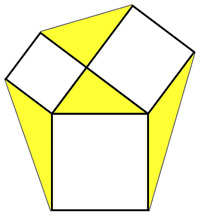 From Futility Closet we have another intriguing problem with what turns out to be a simple and elegant solution.
From Futility Closet we have another intriguing problem with what turns out to be a simple and elegant solution.
“If squares are drawn on the sides of a triangle and external to it, then the areas of the triangles formed between the squares each equal the area of the triangle itself.”
I originally assumed that the center triangle was a right triangle as suggested by the picture. But then I realized there was a solution that did not depend on that. See Four of a Kind.
Polygon Areas Problem
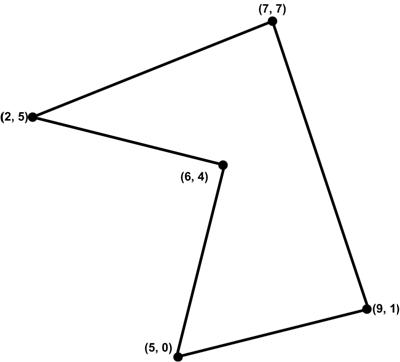 This is another problem from Futility Closet, though Futility Closet provides a “solution” of sorts. They provide a set of steps without explaining where they came from. So I thought I would fill in the gap. The problem is to find the area of an irregular polygon, none of whose sides cross one another, if we are given the coordinates of the vertices of the polygon.
This is another problem from Futility Closet, though Futility Closet provides a “solution” of sorts. They provide a set of steps without explaining where they came from. So I thought I would fill in the gap. The problem is to find the area of an irregular polygon, none of whose sides cross one another, if we are given the coordinates of the vertices of the polygon.
See Polygon Areas Problem for a solution.
Restructuring the US Senate
 This subject admittedly has only a tenuous relationship to mathematics (via arithmetic), but perhaps it can join more mathematically challenging political topics like voting and gerrymandering. In any case, I was stimulated to consider the idea of reapportioning the US Senate by the % US population of each state by an 8 December 2018 article in the Atlantic by former Congressman John Dingell, who advocated abolishing the Senate. I thought this a bit too Draconian and considered the percent population idea as a better compromise. It turned out I was not alone in having this (obvious) thought: I just came across a more extensive 2 January 2019 Atlantic article by Eric Orts that concurs with my idea about reapportionment of the Senate, discusses the legal ramifications in more detail, and echoes the benefits I mentioned as well as others. See Restructuring the US Senate.
This subject admittedly has only a tenuous relationship to mathematics (via arithmetic), but perhaps it can join more mathematically challenging political topics like voting and gerrymandering. In any case, I was stimulated to consider the idea of reapportioning the US Senate by the % US population of each state by an 8 December 2018 article in the Atlantic by former Congressman John Dingell, who advocated abolishing the Senate. I thought this a bit too Draconian and considered the percent population idea as a better compromise. It turned out I was not alone in having this (obvious) thought: I just came across a more extensive 2 January 2019 Atlantic article by Eric Orts that concurs with my idea about reapportionment of the Senate, discusses the legal ramifications in more detail, and echoes the benefits I mentioned as well as others. See Restructuring the US Senate.
Two Pints of Cider
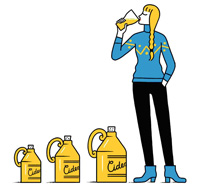 This is another problem from the defunct Wall Street Journal Varsity Math Week column.
This is another problem from the defunct Wall Street Journal Varsity Math Week column.
“Team member Janice recently visited the U.K. and poses this puzzle to her teammates: You have three containers that can hold exactly 15, 10 and 6 pints. The 15-pint container starts full of cider. You want to measure out exactly 2 pints of cider, drink it all, and end with an empty 15-pint container and 8 and 5 pints of cider in the other two containers. What transfers should you make to accomplish this?”
The solution is based on my Three Jugs Problem. See Two Pints of Cider.
The Profession of Engineering
 In light of subsequent events it may be that being a politician requires its own set of skills, but this praise of his profession of engineering before he became president casts the unfortunate Herbert Hoover in a different light. My father brought this surprising excerpt from Hoover’s autobiography to my attention years ago. I have highlighted the part that is especially insightful. Unfortunately, the balance of the chapter praising an engineer’s involvement in government does not fare as well, given the author, though a subsequent engineer US president, whatever his shortcomings, was never faulted for his honesty and moral rectitude. See the Profession of Engineering.
In light of subsequent events it may be that being a politician requires its own set of skills, but this praise of his profession of engineering before he became president casts the unfortunate Herbert Hoover in a different light. My father brought this surprising excerpt from Hoover’s autobiography to my attention years ago. I have highlighted the part that is especially insightful. Unfortunately, the balance of the chapter praising an engineer’s involvement in government does not fare as well, given the author, though a subsequent engineer US president, whatever his shortcomings, was never faulted for his honesty and moral rectitude. See the Profession of Engineering.
Aesthetic Curiosity – The Root of Invention
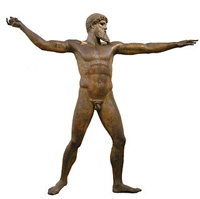 This 1975 New York Times article by Cyril Stanley Smith left an indelible impression over the years to the point that I wanted to capture it in digital format. I found a 1996 copy online, formatted it more closely to the original article, and found more recent images of the illustrations used in the original article. It is a powerful argument for the benefits of basic research vs. directed research. The pursuit of pure mathematics often is accused of being a product of imagination run rampant with no practical purpose. It is argued that Government expenditures of public moneys for research should be applied more to directed research that has specific practical goals with explicit criteria for success. It has always been difficult to argue otherwise. Smith’s article, however, goes a long way toward a rebuttal, as well as showing the benefits of play and artistic creativity for its own sake. See the Aesthetic Curiosity – The Root of Invention.
This 1975 New York Times article by Cyril Stanley Smith left an indelible impression over the years to the point that I wanted to capture it in digital format. I found a 1996 copy online, formatted it more closely to the original article, and found more recent images of the illustrations used in the original article. It is a powerful argument for the benefits of basic research vs. directed research. The pursuit of pure mathematics often is accused of being a product of imagination run rampant with no practical purpose. It is argued that Government expenditures of public moneys for research should be applied more to directed research that has specific practical goals with explicit criteria for success. It has always been difficult to argue otherwise. Smith’s article, however, goes a long way toward a rebuttal, as well as showing the benefits of play and artistic creativity for its own sake. See the Aesthetic Curiosity – The Root of Invention.
Nahin Triangle Problem
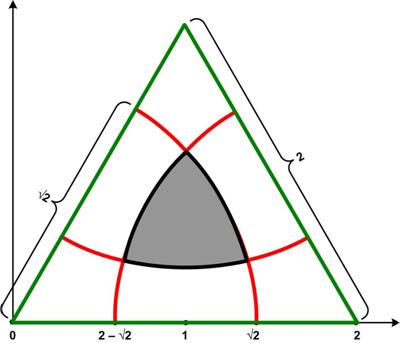 This article is basically a technical footnote without wider significance. At the time I had been reading with interest Paul J. Nahin’s latest book Number-Crunching (2011). Nahin presents a problem that he will solve with the Monte Carlo sampling approach.
This article is basically a technical footnote without wider significance. At the time I had been reading with interest Paul J. Nahin’s latest book Number-Crunching (2011). Nahin presents a problem that he will solve with the Monte Carlo sampling approach.
“To start, imagine an equilateral triangle with side lengths 2. If we pick a point ‘at random’ from the interior of the triangle, what is the probability that the point is no more distant than d = √2 from each of the triangle’s three vertices? The shaded region in the figure is where all such points are located.”
Nahin provided a theoretical calculation for the answer and said that it “requires mostly only high school geometry, plus one step that I think requires a simple freshman calculus computation.” This article presents my solution without calculus. See the Nahin Triangle Problem.
Math and Religion
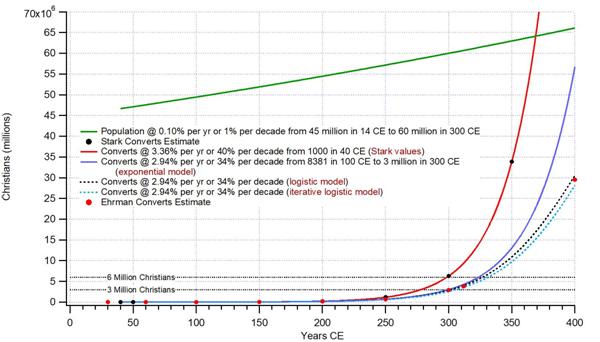 This was a catchy, misleading title that I could not resist, since my essay is not about math vs. religion as one might expect from the title, but rather about math helping religion. Back in 2016 I was reading Dr. Bart D. Ehrman’s blog that he was writing in preparation for his eventual book, The Triumph of Christianity, in which he was considering Rodney Stark’s purely mathematical analysis of the growth of Christianity in the first three centuries. Neither Rodney Stark nor Bart Ehrman described explicitly the underlying mathematical models of exponential growth that they were using and exactly what was meant by a rate of growth. Given the natural audience for the subject, these omissions were not surprising. So I thought I would clarify the math and also offer some variations on the models, which eventually reflected the actual situation more faithfully. See Math and Religion.
This was a catchy, misleading title that I could not resist, since my essay is not about math vs. religion as one might expect from the title, but rather about math helping religion. Back in 2016 I was reading Dr. Bart D. Ehrman’s blog that he was writing in preparation for his eventual book, The Triumph of Christianity, in which he was considering Rodney Stark’s purely mathematical analysis of the growth of Christianity in the first three centuries. Neither Rodney Stark nor Bart Ehrman described explicitly the underlying mathematical models of exponential growth that they were using and exactly what was meant by a rate of growth. Given the natural audience for the subject, these omissions were not surprising. So I thought I would clarify the math and also offer some variations on the models, which eventually reflected the actual situation more faithfully. See Math and Religion.
Angular Momentum
 I have always had a tenuous relationship with the concept of angular momentum, but recently my concerns resurfaced when I did my studies on Kepler, and in particular his “equal areas law” and Newton’s elegant geometric proof. I love the fact that a simple geometric argument, seemingly totally divorced from the physical situation, can provide an explanation for why the line from the Sun to a planet sweeps out equal areas in equal time as the planet orbits the Sun, solely under the influence of the gravitational force between them. However, modern physics books invariably cite the conservation of angular momentum as the “explanation.” I indicated before in my “Kepler’s Laws and Newton’s Laws” essay that this “explanation” irritated me. In this essay I go into detail about my reservations concerning this line of argument. See Angular Momentum.
I have always had a tenuous relationship with the concept of angular momentum, but recently my concerns resurfaced when I did my studies on Kepler, and in particular his “equal areas law” and Newton’s elegant geometric proof. I love the fact that a simple geometric argument, seemingly totally divorced from the physical situation, can provide an explanation for why the line from the Sun to a planet sweeps out equal areas in equal time as the planet orbits the Sun, solely under the influence of the gravitational force between them. However, modern physics books invariably cite the conservation of angular momentum as the “explanation.” I indicated before in my “Kepler’s Laws and Newton’s Laws” essay that this “explanation” irritated me. In this essay I go into detail about my reservations concerning this line of argument. See Angular Momentum.
